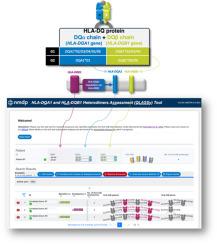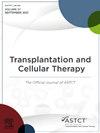A Tool for the Assessment of HLA-DQ Heterodimer Variation in Hematopoietic Cell Transplantation
IF 3.6
3区 医学
Q2 HEMATOLOGY
引用次数: 0
Abstract
When optimizing transplants, clinical decision-makers consider HLA-A, -B, -C, -DRB1 (8 matched alleles out of 8), and sometimes HLA-DQB1 (10 out of 10) matching between the patient and donor. HLA-DQ is a heterodimer formed by the β chain product of HLA-DQB1 and an α chain product of HLA-DQA1. In addition to molecules defined by the parentally inherited cis haplotypes, α-β trans-dimerization is possible between certain alleles, leading to unique molecules and a potential source of mismatched molecules. Recently, researchers uncovered that clinical outcome after HLA-DQB1-mismatched unrelated donor HCT depends on the total number of HLA-DQ molecule mismatches and the specific α-β heterodimer mismatch. Our objective in this study is to develop an automated tool for analyzing HLA-DQ heterodimer data and validating it through numerous datasets and analyses. By doing so, we provide an HLA-DQ heterodimer tool for DQα-DQβ trans-heterodimer evaluation, HLA-DQ imputation, and HLA-DQ-featured source selection to the transplant field. In our study, we leverage 352,148 high-confidence, statistically phased (via a modified expectation-maximization algorithm) HLA-DRB1∼DQA1∼DQB1 haplotypes, 1,052 pedigree-phased HLA-DQA1∼DQB1 haplotypes, and 13,663 historical transplants to characterize HLA-DQ heterodimers data. Using our developed QLASSy (HLA-DQA1 and HLA-DQB1 Heterodimers Assessment) tool, we first assessed the data quality of HLA-DQ heterodimers in our data for trans-dimers, missing HLA-DQA1 typing, and unexpected HLA-DQA1 and HLA-DQB1 combinations. Since trans-dimers enable up to four unique HLA-DQ molecules in individuals, we provide in-silico validations for 99.7% of 275 unique trans-dimers generated by 176,074 U.S. donors with HLA-DQA1 and HLA-DQB1 data. Many individuals lack HLA-DQA1 typing, so we developed and validated high-confidence HLA-DQ annotation imputation via HLA-DRB1 with >99% correct predictions in 23,698 individuals. A select few individuals displayed unexpected HLA-DQ combinations. We revisited the typing of 61 donors with unexpected HLA-DQ combinations based on their HLA-DQA1 and HLA-DQB1 typing and corrected 22 out of 61 (36%) cases of donors through data review or retyping and used imputation to resolve unexpected combinations. After verifying the data quality of our datasets, we analyzed our datasets further: we explored the frequencies of observed HLA-DQ combinations to compare HLA-DQ across populations (for instance, we found more high-risk molecules in Asian/Pacific Islander and Black/African American populations), demonstrated the effect of HLA-DQA1 and HLA-DQB1 mismatching on HLA-DQ molecular mismatches, and highlighted where donor selections could be improved at the time of search for historical transplants with this new HLA-DQ information (where 51.9% of G2-mismatched transplants had lower-risk, G2-matched alternatives). We encapsulated our findings into a tool that imputes missing HLA-DQA1 as needed, annotates HLA-DQ (mis)matches, and highlights other important HLA-DQ data to consider for the present and future. Altogether, these valuable datasets, analyses, and a culminating tool serve as actionable resources to enhance donor selection and improve patient outcomes.

评估造血细胞移植中 HLA-DQ 异源二聚体变异的工具:HLA-DQ 异源二聚体工具。
背景:在优化移植时,临床决策者会考虑患者和供体之间的 HLA-A、-B、-C、-DRB1(8 个等位基因中有 8 个匹配),有时也会考虑 HLA-DQB1 (10 个等位基因中有 10 个匹配)。HLA-DQ 是由 HLA-DQB1 的 β 链产物和 HLA-DQA1 的 α 链产物组成的异源二聚体。除了由父母遗传的顺式单倍型确定的分子外,某些等位基因之间也可能发生α-β反式二聚化,从而产生独特的分子和潜在的不匹配分子。最近,研究人员发现,HLA-DQB1 不匹配的非亲缘供体 HCT 后的临床结果取决于 HLA-DQ 分子错配的总数和特定的 α-β 异源二聚体错配:本研究的目的是开发一种自动工具,用于分析 HLA-DQ 异源二聚体数据,并通过大量数据集和分析进行验证。通过这样做,我们为移植领域提供了一种用于 DQα-DQβ 反式异源二聚体评估、HLA-DQ 估算和 HLA-DQ 特征源选择的 HLA-DQ 异源二聚体工具:在我们的研究中,我们利用了 352,148 个高置信度、统计分期(通过改进的期望最大化算法)的 HLA-DRB1∼DQA1∼DQB1 单倍型,1,052 个血统分期的 HLA-DQA1∼DQB1 单倍型,以及 13,663 例历史移植来描述 HLA-DQ 异源二聚体数据:利用我们开发的QLASSy(HLA-DQA1和HLA-DQB1异二聚体评估)工具,我们首先评估了数据中HLA-DQ异二聚体的数据质量,包括反式二聚体、HLA-DQA1分型缺失以及意外的HLA-DQA1和HLA-DQB1组合。由于反式二聚体能在个体中产生多达四种独特的 HLA-DQ 分子,我们为 176,074 名美国供体产生的 275 个独特反式二聚体中 99.7% 的 HLA-DQA1 和 HLA-DQB1 数据提供了校内验证。许多个体缺乏 HLA-DQA1 分型,因此我们开发并验证了通过 HLA-DRB1 进行的高可信度 HLA-DQ 注释归约,在 23,698 个个体中预测的正确率大于 99%。少数个体显示了意外的 HLA-DQ 组合。我们根据供体的 HLA-DQA1 和 HLA-DQB1 分型,重新对 61 例具有意外 HLA-DQ 组合的供体进行了分型,并通过数据审查或重新分型纠正了 61 例供体中的 22 例(36%),并使用归因法解决了意外组合的问题。在验证了数据集的数据质量后,我们对数据集进行了进一步分析:我们探究了观察到的 HLA-DQ 组合的频率,以比较不同人群的 HLA-DQ(例如,我们在亚洲/太平洋岛民和黑人/非洲裔美国人中发现了更多的高风险分子),证明了 HLA-DQA1 和 HLA-DQB1 错配对 HLA-DQ 分子错配的影响,并强调了在利用这些新的 HLA-DQ 信息搜索历史移植时,可以改进供体选择的地方(其中 51.结论:我们将研究结果汇总到一个工具中,该工具可根据需要计算缺失的 HLA-DQA1,注释 HLA-DQ(错误)匹配,并强调当前和未来需要考虑的其他重要 HLA-DQ 数据。总之,这些有价值的数据集、分析和最终工具都是可操作的资源,可用于加强供体选择和改善患者预后。
本文章由计算机程序翻译,如有差异,请以英文原文为准。
求助全文
约1分钟内获得全文
求助全文
来源期刊

Transplantation and Cellular Therapy
Medicine-Hematology
CiteScore
7.00
自引率
15.60%
发文量
1061
审稿时长
51 days
 求助内容:
求助内容: 应助结果提醒方式:
应助结果提醒方式:


